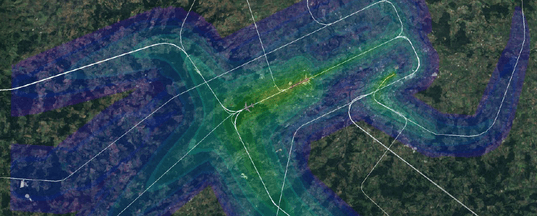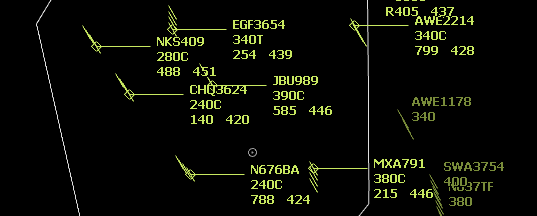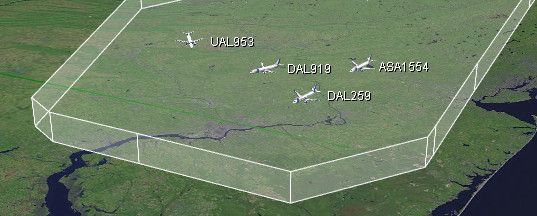The AgentFly ATM Aircraft Simulation is a comprehensive software solution for fast-time, large-scale air traffic simulation. The simulation is provided as an off-the-shelf product, a customizable R&D product, or as a service for client-specific studies.
AgentFly ATM Aircraft Simulation
Off-the-shelf product | Customizable R&D product | Client-specific studies

Key benefits
- Enables fast-time “what-if” scenario comparisons and evaluations
- Provides extensive analytics and customized reporting of simulation results
- Supports environmental assessments for fuel consumption, emissions, and noise
Features
- Runway-to-runway aircraft simulation using a realistic 4D trajectory planner
- Aircraft modeling based on BADA performance data
- Supports a wide range of inputs and outputs
- Rich presentation capabilities
Functionalities
- Runway-to-runway aircraft simulation using a realistic 4D trajectory planner
- Aircraft modeling based on BADA performance data
- Aircraft trajectory planning includes:
- Application of SID/STAR and final approach routes
- Runway selection based on airport configuration or wind conditions
- Automated altitude climb based on fuel consumption
- Supports a wide range of input data:
- Airspace: fixes, routes, sectors, sectorizations, restrictions, LoAs, wind
- Flights: flight plans, replay tracks
- Ground: runways, terrain, ambient noise, population densities
- Computed Outputs:
- Sector metrics: occupancy, entries, flight levels
- Aircraft metrics: distance flown, flight duration, detected conflicts
- Environmental metrics: fuel consumption, emissions
- Noise analysis: aircraft only, combining with background noise and population density
- Presentation:
- 2D and 3D visualization: traffic, airspace data, heatmap overlays
- Detailed information: flights, sector data
- Dynamic charts: individual, aggregated, predefined, or user-defined
- Export capabilities: flight positions, computed data, charts
ATM Enroute Simulation
Customizable R&D product | Client-specific studies
The AgentFly ATM Enroute Simulation is software for evaluating, validating, and optimizing the airspace, workload of air traffic controllers, air traffic, and new ATM concepts and tools. The AgentFly system is a fast-time, large-scale simulation of en-route areas. The simulation can be provided as a product installed at the customer site or as a service for commercial and research studies.

Key benefits
- Realistic ATCO cognitive behavior model to compute workload and taskload
- Fast-time what-if analysis for scenario comparisons and evaluation
- Extensive analytics and customized reporting of the simulation results
- Environmental assessment for fuel consumption and emissions
- Real-time integration with human-in-the-loop simulators to increase realism and lower the number of human ATCO feeders and pseudopilots
- Tailored solution for each customer with the flexibility to implement specific adjustments, features, tools, data formats, and new concepts
- Integration of general aviation
Features
- Aircraft modeling using the BADA performance model
- Supporting multiple input data formats - airspace definition, flights, and environment
- Extensive configuration of simulation behavior tuned for specific customer needs
- ATCO behavior configurable using tasks allowing modeling executive, planning, traffic manager, and custom-defined roles
- System's main features include:
- Dynamic sectorization based on predicted workload, entries, and occupancy
- Realistic and configurable detection and conflict resolution
- Emulation of communications - radio, datalink, telephone, and SYSCO
- Modeling the impact of wind and convective weather
ATM Terminal Area Simulation
Customizable R&D product | Client-specific studies
The AgentFly ATM Terminal Area Simulation is software for evaluating, validating, and optimizing the airspace, workload of air traffic controllers, air traffic, and new ATM concepts and tools. The AgentFly system is a fast-time, large-scale simulation focusing on specific traffic behavior in terminal areas. The simulation can be provided as a product installed at the customer site or as a service for commercial and research studies.

Key benefits
- Realistic ATCO cognitive behavior model to compute workload and taskload
- Fast-time what-if analysis for scenario comparisons and evaluation
- Extensive analytics and customized reporting of the simulation results
- Environmental assessment for fuel consumption and emissions
- Real-time integration with human-in-the-loop simulators to increase realism and lower the number of human ATCO feeders and pseudopilots
- Tailored solution for each customer with the flexibility to implement specific adjustments, features, tools, data formats, and new concepts
- Integration of general aviation
Features
- Aircraft modeling using the BADA performance model
- Supporting multiple input data formats - airspace definition, flights, and environment
- Extensive configuration of simulation behavior tuned for specific customer needs
- ATCO behavior configurable using tasks allowing modeling departure, arrival, director, traffic manager, and custom-defined roles
- System's main features include:
- Dynamic sectorization based on predicted workload, entries, and occupancy
- Metering, miles/minutes-in-trail, traffic ordering for runways
- Emulation of communications - radio, datalink, telephone, and SYSCO
- Modeling the impact of wind and convective weather

